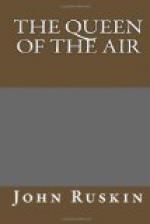Babes should not be swaddled with their hands bound down to their sides: therefore they should be thrown out to roll in the kennels naked.
None of these arguments are good, and the practical issues of them are worse. For there are certain eternal laws for human conduct which are quite clearly discernible by human reason. So far as these are discovered and obeyed, by whatever machinery or authority the obedience is procured, there follow life and strength. So far as they are disobeyed, by whatever good intention the disobedience is brought about, there follow ruin and sorrow. And the first duty of every man in the world is to find his true master, and, for his own good, submit to him; and to find his true inferior, and, for that inferior’s good, conquer him. The punishment is sure, if we either refuse the reverence, or are too cowardly and indolent to enforce the compulsion. A base nation crucifies or poisons its wise men, and lets its fools rave and rot in the streets. A wise nation obeys the one, restrains the other, and cherishes all.
157. The best examples of the results of wise normal evidence in Art will be found in whatever evidence remains respecting the lives of great Italian painters, though, unhappily, in eras of progress, but just in proportion to the admirableness and efficiency of the life, will be usually the scantiness of its history. The individualities and liberties which are causes of destruction may be recorded; but the loyal conditions of daily breath are never told. Because Leonardo made models of machines, dug canals, built fortifications, and dissipated half his art-power in capricious ingenuities, we have many anecdotes of him;—but no picture of importance on canvas, and only a few withered stains of one upon a wall. But because his pupil, or reputed pupil, Luini, labored in constant and successful simplicity, we have no anecdotes of him;—only hundreds of noble works. Luini is, perhaps, the best central type of the highly-trained Italian painter. He is the only man who entirely united the religious temper which was the spirit-life of art, with the physical power which was its bodily life. He joins the purity and passion of Angelico to the strength of Veronese: the two elements, poised in perfect balance, are so calmed and restrained, each by the other, that most of us lose the sense of both. The artist does not see the strength, by reason of the chastened spirit in which it is used: and the religious visionary does not recognize the passion, by reason of the frank human truth with which it is rendered. He is a man ten times greater than Leonardo;—a mighty colorist, while Leonardo was only a fine draughtsman in black, staining the chiaroscuro drawing, like a colored print: he perceived and rendered the delicatest types of human beauty that have been painted since the days of the Greeks, while Leonardo depraved his finer instincts by caricature, and remained to the end of his days




